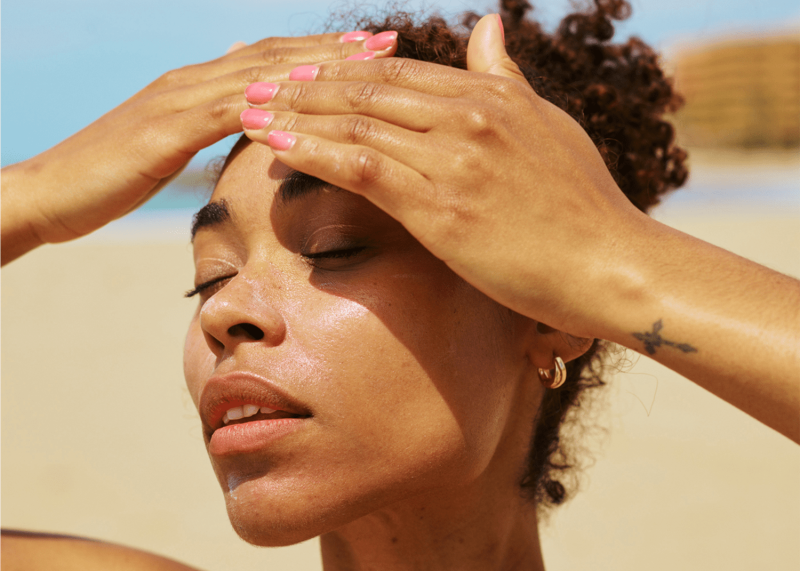
Risks Preventive Care The Takeaway
Let’s be real: sunburn happens. Sometimes, no matter how much you spray and slap on sunscreen, you simply miss a spot. Or, you were having so much fun in the sun that you forgot to reapply and now you’re in full lobster mode. No one likes looking like a tomato and feeling like their skin is on fire. The urge to scratch that very painful itch can be a tough one to resist. And let’s not get into the aftermath of peeling skin.
Luckily, there are steps you can take after a bad burn to calm it. We turned to two expert dermatologists for their top tips on sunburn itch relief. Here’s everything you need to know to soothe your skin.
What Is Sunburn?
“Sunburn is the term we use to describe an acute inflammatory skin reaction which results from extended exposure to UV rays, whether from the sun or artificial sources like tanning beds,” explains Whitney Bowe, MD, FAAD, board-certified dermatologist and founder of Dr. Whitney Bowe Beauty.
The inflammatory reaction from UV rays damaging skin cells is what causes the skin to appear red. “The immune system reacts by increasing blood flow to the affected areas and may lead to the skin feeling warm,” says Marisa Garshick, MD, FAAD, board-certified dermatologist in NYC and Englewood NJ, and clinical assistant professor of dermatology at Weill Cornell Medicine. “With more severe sunburns, blisters may appear as a result of a deeper and more intense inflammatory reaction that causes further damage to the skin cells.”
Why Sunburn Causes Itching
“The itching and discomfort you experience with sunburn is a result of the damage to the skin’s outer layers from the UV rays which causes inflammation,” Dr. Bowe says. “As part of the inflammatory response, there is a release of histamine which can cause sensations of both itch and pain.” Dr. Garshick adds that some cells can be so damaged that they die off, leading to the peeling that we can see with getting a sunburn, which may also be associated with itching.
Treatment Options
Prevention is the best treatment, but there are a few home remedies for sunburn itch relief.
- Cool the skin: “Cooling the skin down by applying cool compresses or taking a cool shower can be helpful, especially initially when the skin feels hot,” Dr. Garshick says. “For those who prefer a topical, using aloe vera or menthol-based lotions can help provide a cooling and soothing effect.”
- Use hydrating and moisturizing products on the target area: “Use skincare products with moisturizing and hydrating ingredients like ceramides, lipids, hyaluronic acid, and glycerin that will help to repair the skin barrier,” says Dr. Garshick.
- Avoid further sun exposure: “It may seem obvious but the skin is more sensitive when it is sunburned so it is especially important to avoid further exposure which can risk slowing down the healing time,” Dr. Garshick says. “Since the skin may be more sensitive, it may be best to opt for a mineral sunscreen which is less likely to irritate the skin.”
- Skip drying or irritating additives and fragrances: Steer clear of any ingredients that are potentially drying or irritating, like exfoliating acids or retinoids, advises Dr. Garshick. “Avoid using alcohol-based products which can irritate and dry skin and make sunburns feel worse,” she says. “Heavily-fragranced products may also be irritating so it is best to avoid products containing a lot of fragrance. You do not want to increase your chances of a reaction when skin is already inflamed.”
- Calm inflammation: Dr. Bowe suggests starting with an NSAID—Ibuprofen, Aleve, or Advil (she doesn’t reach for Tylenol here). “I love aloe but I don’t recommend applying aloe directly from the plant because of anthraquinones which can cause irritation or an allergy,” she says. “So, I recommend buying an aloe-based product from the store instead. I know some people love to apply aloe directly from the plant and if that works for you, you do you.”
- Drink lots of water: You might also experience what’s called third spacing of fluid—fluid going from vessels to your skin—which means you’re at risk of dehydration, so drink lots of water to stay hydrated,” Dr. Bowe says.
- Vaseline: Dr. Bowe recommends using Vaseline to soothe sunburns but only after waiting an initial 24 hours. “Vaseline can be a bit too occlusive if you use it too soon after a burn,” she explains. “Topical steroids like triamcinolone are not very effective for sunburn but if you have facial swelling or flu-like symptoms, you might be prescribed an oral steroid like prednisone.”
In the case of a bad sunburn, professional medical attention may be necessary. “If you have large blisters or blisters that cover more than 20% of your body, I recommend seeing a doctor,” Dr. Bowe says. “If you experience severe swelling, signs of infection such as blisters filled with pus, or you notice systemic symptoms like confusion, nausea, fever or chills, I would recommend consulting a physician.”
Risks
The immediate risks of a sunburn include risk of infection, dehydration, blistering and scarring of the skin, warns Dr. Garshick. “Sunburns not only increase your risk for developing skin cancer down the road, but they also increase the risk of developing signs of aging prematurely,” Dr. Bowe says. “Sunburns and cumulative sun exposure can increase your risk for developing fine lines, wrinkles, discoloration, rough texture and loss of elasticity of the skin.”
Preventive Care
“As a dermatologist, of course, I emphasize that preventative care is the best approach when it comes to sunburn,” Dr. Bowe says. “It doesn’t have to be complicated or time intensive. For example, rather than reapplying sunscreen to my body all day long at the beach or pool, I streamline and simplify the process by wearing UPF fabrics (for example, a UPF rashguard) to protect my skin from sun damage. I also regularly wear a hat with a wide brim when I’m outdoors for extended periods of time during the spring and summer months. I love spending time outdoors with my friends and family and playing tennis and golf all summer long. But, these simple steps help me to avoid sunburn and keep my skin healthy.”
It’s important to apply sunscreen thoroughly and remember to reapply. A good rule of thumb is to use two finger lengths of sunscreen to cover your face, and a shot glass full of sunscreen to cover the body, according to Dr. Bowe. Reapply every two hours if the skin is dry, but even more frequently if you are swimming or sweating. “If you’ve ever forgotten to apply sunscreen to your part, you know that you’ll never forget again!” she says. “I’ve definitely been there and it hurts. Same goes for the other areas that are frequently overlooked: tops of the ears, eyelids, and the back of your neck. Just knowing the places that we often forget makes a big difference in taking steps to protect them when you’re at the pool or beach.”
The Takeaway
The reality is sunburn does happen, so for sunburn itch relief, follow the protocol above. “Once a sunburn has occurred, it can help to calm and soothe the skin using gentle products including cleansers and moisturizers,” Dr. Garshick says. “Avoid picking or peeling the skin as this can increase the potential for scarring. After a sunburn has occurred, it is especially important to avoid direct sun exposure and to wear sunscreen as the skin is extra sensitive and can be susceptible to more damage.”

